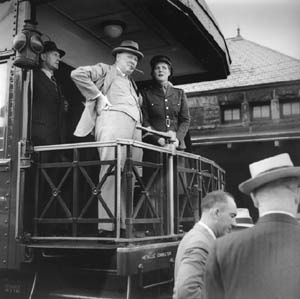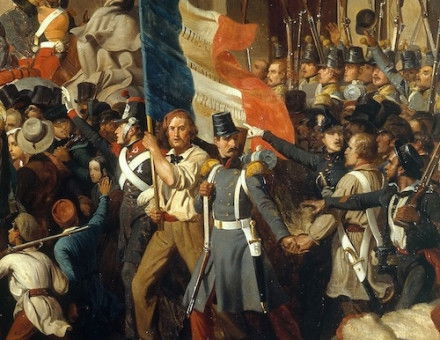Taking the First Bullet for Churchill
Peter Furtado introduces the man closer to Winston Churchill than any other.

Question: Can you name the tall, strong-featured man standing behind Winston Churchill in the photograph? A clue: he is the man who spent more time with the prime minister during the war years than any other. Answer: Walter H. Thompson, his bodyguard from the early 1920s to the end of the Second World War.
Though Thompson is not entirely unknown to history – he wrote The Guard from the Yard in 1938 and I Was Churchill’s Shadow in 1951 – his extraordinary full story has only just emerged, in the form of a 360,000 word typescript prepared by his wife Mary Shearburn (herself a secretary to Churchill in the war) after his retirement in 1945. It was recently discovered in a suitcase by Thompson’s great-niece, and forms the core of a book and major TV series, both scheduled for release this month. In it he tells hair-raising stories of more than twenty brushes with death over the twenty-four years between the early 1920s and the end of the war that Thompson was with Churchill. More than half of these incidents, many of them very real threats, have been unknown until now.
As Philip Nugus, maker of the series, says, the discovery of his manuscript offers a whole new dimension to the career of Britain’s leading statesman. ‘I was amazed at the close-up commentary of events, which had never been shown in such a light before.’
Over the years, Churchill’s career brought him face to face with a wide range of dangerous opponents, and the incidents described by Thompson reflect this. Early examples included during the Irish Civil War, when the IRA laid an ambush for him as he drove to work through Hyde Park in 1921, and when Churchill went to Cairo the same year and endured several attempts on his life by Arab nationalists in Alexandria that were foiled by Thompson and T.E. Lawrence. In the 20s, Thompson even protected Churchill from possible attack by suffragettes, at one point being detailed to trail Christabel Pankhurst around London. When Churchill was in hospital after his car accident in New York in 1931, Thompson had to wrestle an intruder to the ground in the next room, and saved him from an Indian Nationalist assassin in the USA in the mid-30s. In 1939, as war began, a Nazi plan was foiled on the occasion of a trip to the Duke of Windsor in Antibes to shoot the outspoken anti-appeaser, and once Churchill became installed as prime minister, Thompson’s services were required several times, in France, in the North Atlantic, on the Downing St roof and in Athens, where the Greek Communists made several determined attempts on his life. The list goes on and on.
Thompson, brought up in the East End, had happened to hear shots one day in January 1911 and went to Sidney St where he saw the bumptious young Home Secretary (as he thought Churchill) conducting the siege against a group of anarchists. A few years later, during which Thompson joined the police and briefly served as bodyguard to Lloyd George (an assignment he did not enjoy, disapproving of the Prime Minister’s private life), he was given a new job: to guard the Secretary of State for War, Winston Churchill. The two men established an unexpected rapport, and stayed together until 1945, with just a brief break in the 1930s. Churchill himself took an enthusiastic interest in all the potential threats to his life, and together with Thompson practised with small arms and planned how to conduct shoot-outs in his bedroom (he used a steel-backed chair to defend against the threat of an IRA bullet) and elsewhere.
Thompson, who travelled more than 200,000 miles with his charge, records moments of extraordinary insight and intimacy. On one occasion during the war he was alone with F.D. Roosevelt, who asked him to take special care of his boss (Thompson was to build up a close rapport with Roosevelt and his family); on another he attended private talks and dinner with the Big Three in the Kremlin. He had to work with, and perhaps against, the FBI and KGB to ensure the safety of his boss, and was probably privy to Enigma decrypts. To Churchill, Thompson was ‘my faithful vigilant guardian’; and he certainly lived up to this billing. On one occasion during the war, Churchill was suffering a chest infection and Thompson found him having stopped breathing, and alone. Thompson managed to resuscitate him and keep him alive until the doctors could arrive. Churchill returned the favour by providing Thompson’s family with Harley St medical care.
After the war and Churchill’s shattering election defeat in 1945, Thompson records the two men sitting by the fire of Churchill’s London home, reminiscing about the adventures they had been through together. But it was a tale Winston himself perhaps wanted to tell, and Thompson, who had risked life and limb in the service of his boss (though his worst injury had occurred when he dropped the pistol he was carrying and it went off by accident, shooting him in the leg), was permitted to tell only a censored version of his tale. The full story has had to wait until now.




